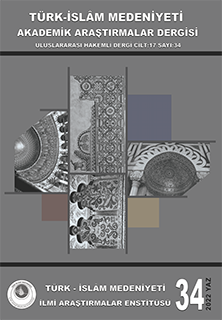Religious Officials appointed by the Prophet
Keywords:
Prophet Muhammed, employment, assignment, religionAbstract
In the first period of Islam, Hz. The duties performed by the religious officials appointed by the Prophet formed the basis of all religious services today. Religious officials appointed by the Messenger of Allah; They fulfilled their duties in many fields such as being an imam, a muezzin, a teacher and a judge, under the guidance of a prophet and conscious of the holiness of their work. Hz. The Prophet called one of the scribes of revelation immediately after the verses and dictated them. Revelation scribes performed an important task in the writing process of the Quran. With his teachers, the Prophet trained people from a society in the age of Jahiliyya to be teachers and guides to all humanity. The Companions, who studied science in a corner of the Masjid an-Nabawi, became the most important messengers of the religion of Islam. In the early periods of Islam, we see that political (ruler) and religious leadership (imam) duties were performed together. While the Imams were in the duty of leading the congregation in prayer with religious terminology, they also assumed the position of head of state with political terminology. Ezan (call to prayer) has been the method of the religion of Islam to invite Muslims to worship. Muezzins have been given the task of announcing the tawhid and prophethood in its content to people with a beautiful voice in order to invite them to prayer. For legal disagreements between people, clerks who can analyze according to Shari (ah) have been appointed. We can say that at the stage of establishing the understanding of society, state and civilization of Islam, religious officials performed important duties.
References
Abdülrezzak, Ebû Bekr Abdürrezzâk b. Hemmâm b. Nâfi‘ es-San‘ânî elHimyerî. (1982). el-Musannef, thk. Habîburrahman el-‛Azamî. Beyrut: Mektebetu’l-İslâmî.
Atalar, M. (1995). “Emîr-i Hac”. Türkiye Diyanet Vakfı İslâm Ansiklopedisi (DİA) 11 (ss.131-133). İstanbul: Türkiye Diyanet Vakfı (TDV) Yayınları.
Atar, F. (2001). “Kadı”. DİA 24 (ss.69-73). İstanbul: TDV Yayınları.
Baktır, M. (2009). “Suffe”. DİA 37 (ss.469- 470). İstanbul: TDV Yayınları.
Boynukalın, M. (2011).“Tebliğ”. DİA 40 (ss. 218, 219). İstanbul: TDV Yayınları.
Buhârî, Muhammed b. İsmâîl. (1986). el-Câmiu’s-Sahîh, nşr. Muhibbuddin Habîb. Kahire: Dâru’r-Reyyân li’t-Türâs.
Ebû Dâvûd, Süleyman b. Eş’as b. İshak. (2009). Süneni Ebî Dâvûd, thk. Şuayb elArnavud. Beyrut: Dâru’l-Kütübi’l-İlmiyye.
El-A‘zamî, Muhammed Mustafa. (1978). Studies in Early Hadith Literature. Indiana U.S.A: American Trust Publications.
Elmalı, A. (2009). Abdullah b. Mes‘ûd ve Hukukî Kişiliği. Doktora Tezi. Dokuz Eylül Üniversitesi. Sosyal Bilimler Enstitüsü. İzmir.
İbn Abdilber, Ebû Ömer Yusuf b. Abdillah en-Nemerî el-Kurtubî. (1992). elİstîâb fî Ma’rifeti’l-Ashâb, thk. Ali Muhammed el-Becâvî. Beyrut: Dâru’l-Cîl.
İbn Hacer, Ahmed b. Ali b. Hacer Ebu’l-Fadl el-Askalânî. (2010). el-İsâbe fî Temyîzi’s-Sahâbe. trc. Naim Erdoğan (Sahâbe-i Kirâm Ansiklopedisi). İstanbul: İz Yayıncılık.
İbn Hacer, Ahmed b. Ali b. Hacer Ebu’l-Fadl el-Askalânî. (1959). Fethu'l-Bârî Şerhü’l-Sahîhi’l-Buhârî. Beyrut: Dâru’l-Marife.
İbn Hişam, Abdülmelik b. Hişam b. Eyyub el-Meâfirî. (2016). es-Sîretü’nNebeviyye, trc. Doç. Dr. Abdülvehhab Öztürk. İstanbul: Kahraman Yayınları.
İbn İshâk, Muhammed b. İshâk b. Yesâr el-Medenî. (2013). Kitâbü’s-Siyer ve’lMegâzî, thk. Süheyl Zekkâr, trc. Ali Bakkal. İstanbul: Harf Yayınevi.
İbn Mâce, Ebû Abdullah Muhammed b. Yezîd Mâce el-Kazvîni. (2013). Sünen, haz. Muhammed Berber. Beyrût: el-Mektebetü’l-Asrıyye.
İbn Sa’d, Muhammed b. Sa’d b. Menî el-Hâşimî el-Basrî. (2015). Kitâbü'tTabakâti'l-Kebîr, thk. Ali Muhammed Ömer, trc. Musa Kazım Yılmaz (Çeviri Heyeti). İstanbul: Siyer Yayınları.
Kettânî, Muhammed Abdülhay. (2012). et-Terâtibü’l-idâriyye (Hz. Peygamberin Yönetimi) trc. Ahmet Özel, İstanbul: İz Yayıncılık.
Koca, F. (2011). Peygamberimiz Hz. Muhammed’in Müezzinleri, Ankara Üniversitesi İlahiyat Fakültesi Dergisi, Cilt: 52:2, , ss. 291-310.
Makrîzî, Ebû Muhammed Takıyyüddîn Ahmed b. Alî b. Abdilkadir b. Muhammed el-Makrîzî. (1997). el-Mevâʿiz ve’l-İʿtibâr bi-Zikri’l-Hıtat ve’lÂsâri. Beyrut: Dârü’l-Kütübi’l-İlmiyye.
Memmedzade, E. (1999). Vahiy Kâtipliği ve Hz. Peygamber’in Vahiy Kâtipleri. Yüksek Lisans Tezi. Ankara Üniversitesi. Sosyal Bilimler Enstitüsü. Ankara.
Nesâî, Ebû Abdurrahmân Ahmed b. Şuʻayb b. Ali. (1991). es-Sünenu’l-Kübrâ, nşr. Abdülğaffâr Süleyman el-Bündârî-Seyyid Kesrevî Hasan. Beyrut: Dâru’l-Kütübi’l-İlmiyye.
Okumuş, M. (2013). Kur’an’ın Tedrici Nüzûl Süreci Bağlamında Mekki ve Medeni Ayetler Üzerine. Eskiyeni Anadolu İlahiyat Akademisi Araştırma Dergisi. Sayı:27. ss.7-21.
Rayyis, Z. (1995). İslâmda Siyasi Düşünce Tarihi, çev: Prof. Dr. İbrahim Sarmış. İstanbul: Nehir Yayınları.
Savaş, R. (2020). İslâm’ın İlk Asrında Kadın, İstanbul: Siyer Yayınları.
Şen, Z. (2006). Kur’an’ın Metinleşme Sürecinde Ortaya Çıkan Problemler. Doktora Tezi. Dokuz Eylül Üniversitesi. Sosyal Bilimler Enstitüsü. İzmir.
Taberî, Muhammed b. Cerîr b. Yezîd el-Âmülî. (1967). Târîhu’r-Rusül ve’lMülûk. Beyrut: Dâru’t-Türâs.
Uraler, A. (2010). “Şifâ Bint Abdullah”. DİA 39 (ss.138-139). İstanbul: TDV Yayınları.
Uzunpostalcı, M. (1994).”Defin” DİA 9 (s. 86). İstanbul: TDV Yayınları.
Vakıdî, Ebû Muhammed b. Ömer b. Vakıd es-Sehmî. (2014). Kitâbü’l-Megâzî, thk. Marsden Johes, trc. Musa K. Yılmaz. İstanbul: İlk Harf Yayınevi.
Yağcı, H. (2009). Hz. Peygamberin Söz ve Davranışlarında İnsan Kazanma Sanatı, Yüksek Lisans Tezi. Yüzüncü Yıl Üniversitesi. Sosyal Bilimler Enstitüsü. Van.
Yavuz, Y. Ş. (2012). “Vahiy”. DİA 42 (ss.443, 447). İstanbul: TDV Yayınları.
Downloads
Published
How to Cite
Issue
Section
License

This work is licensed under a Creative Commons Attribution-NonCommercial 4.0 International License.







